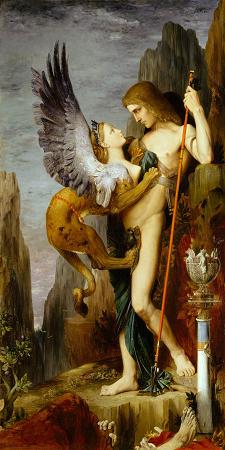
Sphinx. A sphinx is a mythical creature with the head of a human and the body of a lion.
In Greek tradition, the sphinx has the head of a human, the haunches of a lion, and sometimes the wings of a bird. It is mythicised as treacherous and merciless.
Those who cannot answer its riddle suffer a fate typical in such mythological stories, as they are killed and eaten by this ravenous monster. This deadly version of a sphinx appears in the myth and drama of Oedipus.
Unlike the Greek sphinx, which was a woman, the Egyptian sphinx is typically shown as a man. In addition, the Egyptian sphinx was viewed as benevolent, but having a ferocious strength similar to the malevolent Greek version.
Both were thought of as guardians, and often flank the entrances to temples. In European decorative art, the sphinx enjoyed a major revival during the Renaissance. Later, the sphinx image, initially very similar to the original Ancient Egyptian concept, was exported into many other cultures, albeit there often interpreted quite differently due to translations of descriptions of the originals and through evolution of the concept in relation to other cultural traditions. Sphinxes depictions are generally associated with architectural structures such as royal tombs or religious temples. The oldest known sphinx was found 195 kilometres to the east at Kortik Tepe, Turkey, and was dated to 9,500 B.C. The largest
In Greek tradition, the sphinx has the head of a human, the haunches of a lion, and sometimes the wings of a bird. It is mythicised as treacherous and merciless.
Those who cannot answer its riddle suffer a fate typical in such mythological stories, as they are killed and eaten by this ravenous monster. This deadly version of a sphinx appears in the myth and drama of Oedipus.
Unlike the Greek sphinx, which was a woman, the Egyptian sphinx is typically shown as a man. In addition, the Egyptian sphinx was viewed as benevolent, but having a ferocious strength similar to the malevolent Greek version.
Both were thought of as guardians, and often flank the entrances to temples. In European decorative art, the sphinx enjoyed a major revival during the Renaissance. Later, the sphinx image, initially very similar to the original Ancient Egyptian concept, was exported into many other cultures, albeit there often interpreted quite differently due to translations of descriptions of the originals and through evolution of the concept in relation to other cultural traditions. Sphinxes depictions are generally associated with architectural structures such as royal tombs or religious temples. The oldest known sphinx was found 195 kilometres to the east at Kortik Tepe, Turkey, and was dated to 9,500 B.C. The largest
Wikipedia ...